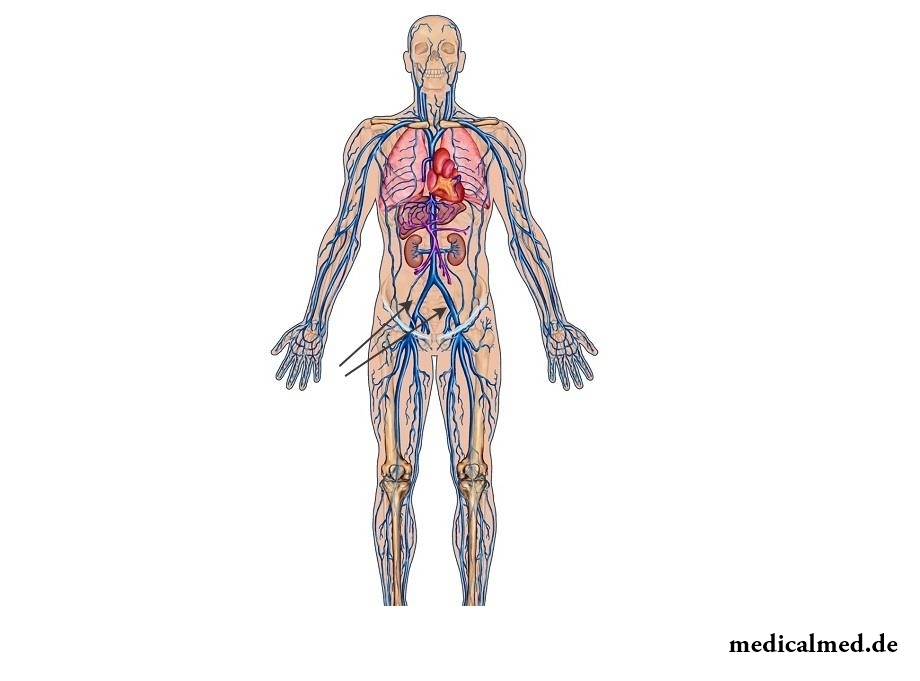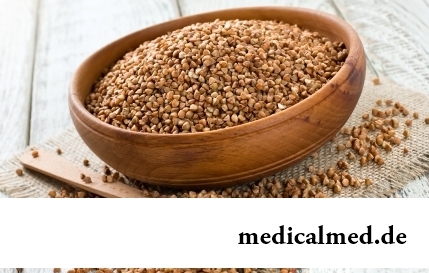





Ileal artery
Ileal artery – the largest after an aorta a pair blood vessel five-seven centimeters long and with a diameter of 11-13 mm. Arteries begin in the place of bifurcation of an aorta, at the level of the fourth lumbar vertebra. In the field of a joint of ileal bones and a sacrum they break up to outside and internal ileal arteries.

The internal artery breaks up to branches - average pryamokishechny, iliolumbar, sacral, lateral, lower and upper buttock, lower vesical, internal sexual, locking. They deliver blood to bodies and internal walls of a pelvic cavity.
Outside artery, leaving a pelvic cavity, in passing gives to its walls several branches and in the lower extremities proceeds in the form of a femoral artery. Branches of a femoral artery (a deep artery, the lower epigastriß artery) deliver blood to skin and muscles to hips, and then branch on smaller arteries and provide blood supply of foot and a shin.
At men the ileal artery delivers blood to small egg covers, hip muscles, a bladder, penis.
Aneurism of an ileal artery
Aneurism of an ileal artery – sacculate protrusion of a vascular wall. The artery wall gradually loses elasticity and is replaced with connecting fabric. The hypertension, an injury, atherosclerosis can be the reasons of formation of aneurism.
Aneurism of an ileal artery long time can proceed without special symptoms. The pain syndrome in the location of aneurism arises if it, reaching the big sizes, begins to squeeze surrounding fabrics.
The rupture of aneurism can serve as the reason of gastrointestinal bleeding of not clear etiology, falling of arterial pressure, decrease in ChSS, a collapse.
Disturbance of blood supply in the field of an arrangement of aneurism can lead to thrombosis of a femoral artery, shin arteries, and also vessels of bodies of a small pelvis. Disturbances of a blood-groove are followed by dysuric frustration, pains. The thrombogenesis in shin arteries sometimes leads to development of paresis, the alternating lameness and emergence of disturbances of sensitivity.
Aneurism of an ileal artery is diagnosed by means of ultrasonography with duplex scanning, a computer tomography, MRT, an angiography.
Occlusion of ileal arteries
Occlusion and stenosis of an ileal artery most often arise owing to an obliterating thromboangitis, atherosclerosis of arteries, a fibromuscular dysplasia, an aortoarteriit.
At a stenosis of an ileal artery the fabric hypoxia develops, breaks fabric exchange. Reduction of oxygen tension in fabrics leads to a metabolic acidosis and accumulation of nedookislenny products of metabolism. At the same time aggregation and adhesive properties of thrombocytes increase, and dezagregatsionny properties decrease. Viscosity of blood increases, and it inevitably leads to formation of blood clots.
Distinguish the following types of occlusion of ileal arteries (depending on an etiology): a nonspecific aortitis, the mixed form of arteritis, an aortitis and atherosclerosis, iatrogenic, post-embolic, posttraumatic occlusions. Depending on the nature of defeat distinguish chronic occlusion, acute thrombosis, a stenosis.
Occlusion of ileal arteries is followed by emergence of a number of syndromes. The syndrome of ischemia of the lower extremities is shown in the form of the paresthesia slight for fatigue and the alternating lameness, numbness and a chill of the lower extremities. The syndrome of impotence is shown in ischemia of bodies of a small pelvis and a chronic circulatory unefficiency of lower parts of a spinal cord.
Conservative treatment of occlusion of ileal arteries is applied to normalization of processes of a blood coagulation, stopping of a pain syndrome, expansion of collaterals and removal of vasospasms.
In case of conservative therapy of the struck vessels it is possible to apply the following medicines:
- means of ganglioblokiruyushchy action (Mydocalmum, Bupatolum, Vasculatum);
- means of a pancreas (dilminat, angiotrophine, андекалин);
- spasmolytic medicines (Nospanum, papaverine).
Serve as surgical indications:
- the expressed alternating lameness or rest pain;
- necrotic changes of tissues of extremity (urgent operation);
- embolism of large and average arteries (immediate surgery).
Methods of surgical treatment of occlusion of ileal arteries:
- resection of an affected area of an artery and its replacement with a transplant;
- endarterectomy – opening of a gleam of an artery and removal of plaques;
- combination of shunting and resection to endarterectomy;
- lumbar sympathectomy.
Now the method of X-ray endovascular dilatation quite often is applied to recovery of the arteries affected with a stenosis. This method with success is applied as addition to reconstructive operations at multiple defeats of vessels.
Our kidneys are capable to clear three liters of blood in one minute.

The kid who was recently born is surrounded with love of adult family members and their cares without which the baby cannot exist....
Section: Articles about health
The way of life of people promptly changes from year to year: if about ten years ago the personal computer was not in each family, then today already very few people do without this device. Certainly, and children master the computer at full speed: they not only I play...
Section: Articles about health
The number of long-livers is very small. One person from 5 thousand lives up to age of 90 years, and the centenary boundary steps over only one of 20 thousand. However, doctors claim that each of us is quite able to affect own destiny. At the same time it is not so much about living as long as possible, how many about an opportunity to keep physical and intellectual activity and to avoid decrepitude. We will also talk about the ways helping to achieve this result today....
Section: Articles about health
Practice of hypnotic impact on consciousness of the person contains about two millennia. During this time scientists were in time a lot of things узн...
Section: Articles about health
All know that self-treatment is dangerous. However absolutely it is almost impossible to do without it. Rate of modern life does not allow to handle each small trouble to the doctor and information on ways of independent rendering medical the help...
Section: Articles about health
The business lady, the become mother, it is necessary to solve an array of problems. But of them is main: how to combine the beloved child and work? What traps trap the working mother and how she needs to behave?...
Section: Slideshow
Today about 30 diseases, sexually transmitted are known. To wide circulation of these illnesses extremely with...
Section: Articles about health
Epilepsy is one of widespread neurologic diseases. Parents, whose children suffer from this illness, should face rumors and delusions, many of which remained since the Middle Ages....
Section: Articles about health
The popular expression "run from a heart attack" became the motto of the people supporting active lifestyle. Moreover, run became a peculiar fashionable tendency: sales of racetracks and the accompanying goods for run are at permanently high level. Whether really it is possible for one and all people and it is necessary to run to receive the portion of health, a charge of cheerfulness and good mood?...
Section: Articles about health
The next flu epidemic leads to the next panic, from year to year we give in on these manipulations: professionally alarming goal...
Section: Articles about health
Scientists always aimed to offer fundamental explanations for medical problems. Their theories formed the basis of modern methods of treatment of the hardest pathologies and helped to save a set of lives. However stories are known also such theoretical constructions, following to...
Section: Articles about health
All got used long ago that, having addressed the plastic surgeon, it is possible to modify natural parameters of a figure or to minimize the damages put to appearance with ruthless time. Many people (preferential women) worldwide annually decide on operations such. However there are also much more exotic interventions which are carried out seldom so far and cost expensive very much. We bring the story about the most unusual of them to your attention....
Section: Articles about health
The mankind knows that some toxins at intake in the minimum quantities have therapeutic effect...
Section: Articles about health
Within several decades of our compatriots convinced that the use of butter nasty affects a condition of coronary vessels. As a result the reputation of a product was impaired thoroughly a little, and many almost ceased to include...
Section: Articles about health
One of the major chemical processes happening in a human body are oxidation reactions. They go with participation of fats and carbohydrates which we receive from food, and the oxygen getting to us from air. A main goal of such reactions is obtaining the energy necessary for life activity. Unfortunately, as a result of these processes dangerous by-products – so-called free radicals are allocated. To minimize harm which they can cause to the person neo...
Section: Articles about health
Each failure in work of bodies and systems of a human body is, as a rule, shown by the whole complex of symptoms. In particular, N...
Section: Articles about health
Life activity of one-celled fungi of the sort Candida, related to yeast is a proximate cause of development of candidiasis (milkwoman). Normal these microorganisms are a part of the microflora living in an oral cavity and intestines of most of people, and that...
Section: Articles about health
According to data of World Health Organization, the cataract is diagnosed almost for 7% of the population of Earth. The statistics of incidence is considered not full as at an initial stage the illness, as a rule, does not cause to the person of special inconveniences, and many diseased sees doctors not at once. The cataract is not only one of the most widespread ophthalmologic illnesses, but also the reason of a half of cases of loss of sight....
Section: Articles about health
Physical activity is necessary for normal functioning of a human body. At a lack of the movement cease функц...
Section: Articles about health
History of cultivation of a buckwheat contains more than five thousand years. Grain which is received from this plant is used for preparation of porridges, soups, baked puddings and puddings, do flour which is one of the main ingredients of the noodles popular in of it...
Section: Articles about health
With age in a human body harmful substances collect. We receive them with food and water, at inhalation of the contaminated air, reception of medicines, use of household chemicals and cosmetics. A considerable part of toxins accumulates in a liver which main function is continuous purification of blood. This body begins to knock as any got littered filter, and efficiency of its work decreases....
Section: Articles about health
Any person who faced a disease knows that treatment costs expensive. It belongs also to consultations qualified the specialist...
Section: Articles about health
All the known slogan "Protect Men!" arose not from scratch. In a sense, the nature created men much less adapted for vital disorders, than it seems at first sight. Statistically, men are ill more often...
Section: Articles about health
Work of a brain is extremely complex and in many respects is not studied yet. It is confirmed also by the features of thought processes which are shown when the person sleeps. Let's tell about some of them....
Section: Articles about health
Cellulitis - very widespread cosmetic shortcoming which arises approximately at 80% of women sooner or later. Emergence ег...
Section: Articles about health
Quite large number of people adheres to the principles of vegetarian food. But how to be if in a family of vegetarians there are children? Whether it is possible to eat also it the same as to parents, or after all the children's organism is not adapted for the use only раст...
Section: Articles about health
Aspirin (acetylsalicylic acid) – one of those drugs which are known literally to all. It is available in each home first-aid kit, and many accept it at the first signs of an indisposition, often without having a fair idea of properties and therapeutic effect of drug. Meanwhile, impact of aspirin on a human body is very various, and is not always favorable. About it it is important to foreknow, in order to avoid emergence of problems with health....
Section: Articles about health
